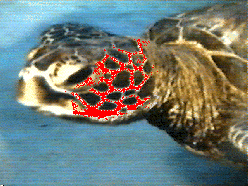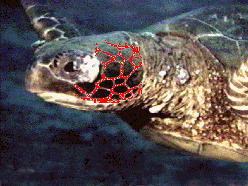 |
 |
| Clothahump, 1988 (56K JPEG) |
Clothahump, 1993 (73K JPEG) |
One of the first questions that occurs to people hearing about our turtle experiences is, "How do you tell them apart?" This question is of the utmost importance to us. If we could not tell them apart, we could not document the changes in a each turtle's tumors from year to year.
The answer is in the faces. Although some turtles are readily identifiable by some obvious characteristic, such as Noke's missing flipper, many turtles look alike at a casual glance--but not if you examine the turtle's "mug shots" closely.
Like people, turtles have individual faces. Most honu have 15-20 darkish scales on their cheeks, although some have more and some less. Regardless of number, the shape and arrangement is constant and in our experience, unique. This provides a way to tell honu apart.
While we can't prove definitively that no two turtles share the same facial pattern, we have collected plenty of documentation to show that within the Honokowai population, turtle profiles are a reliable way of identifying individual turtles.
The two portraits from the Dedication provide an excellent example of how this works. Clothahump was the first turtle we met, back in 1988. The image on the left is a portrait from that year. The image on the right was taken the last time we saw her, in 1993. The facial pattern in each picture has been highlighted in red for emphasis.
Now examine the diagram formed by removing everything except the red mask:
Look at the shape of the areas marked by each letter. We chose to begin with the small area labelled a because it forms the centre of the principle pattern on Clothahump's left profile. Surrounding this centrepiece are five larger areas, b through f, forming a floral pattern. Below and to the left, areas g, h, and i form a secondary pattern.
This combination is unlike any other we have seen. For many other reasons, we know that the tumored turtle we saw in 1993 was the same curious juvenile we met in 1988, but this demonstration should convince even the most skeptical of observers.
By the end of 2004, we'd logged nearly 700 individual turtles. Since there are left and right profiles, we have over 1300 facial patterns in our database. We have yet to encounter two patterns that look identical upon study. Most patterns can be distinguished from one another with a casual glance. When left and right profiles for a turtle are paired, we consider the chance of a duplicate animal to be insignificant. We firmly believe that used in pairs, closely examined turtle profiles are a dependable way to identify an individual.
We don't claim that we can identify all the Honokowai turtles with a quick glance underwater. We do try to memorize as many faces as possible, looking for unique configurations for each turtle. Goofyfoot has a foot pattern (24K JPEG) that is a classic example. We can identify most of the regulars underwater, but for irregular visitors, we rely on the video camera and enhancement techniques similar to the one demonstrated here.
Like the facial patterns, the patterns formed on each turtle's flipper turn out to be both unique and unchanging over the years. We began using this technique because we had a 1997 photograph of a turtle's profile that wasn't sharp enough for positive identification. The pattern on the right front flipper was clear, however, and we were able to match this with a 1989 photograph that included both profile and flipper pattern. Not only was this our first use of the method, it happened to confirm that we can trace that animal, Kaula, further back than any other Honokowai turtle.
Unfortunately, we have not yet converted the Kaula photographs into graphics for the Web, but once that is done we'll post them here. Meanwhile, we offer two demonstrations of the technique.
First, we present two clear colour images that illustrate how easy it is to see that the patterns are identical. The coloured dots emphasize parts of the pattern that are distinctive and identical in both pictures. As the captions note, these are pictures of Hilu's right front flipper, taken two years apart. The larger image (75K JPEG) includes the turtle's profile, confirming that it is indeed the same animal.
Our second example shows two things:
These images of Nui's right front flipper are captured from videotape and reduced to greyscale in order to emphasize the contrast. Again, the coloured dots emphasize parts of the pattern that are distinctive, and the larger image (50K JPEG) includes the facial profile for confirmation.
While we will continue to use facial profiles as our primary means of turtle identification, we are excited by the potential of flipper patterns. In some cases, we encounter turtle whose profile has been obliterated by tumors (36K JPEG). By examining the patterns on the flippers of these animals, we might be able to determine if we are seeing a turtle whose face we once knew.
Last modified 04/10/09
Send comments or corrections to webmaster@turtles.org